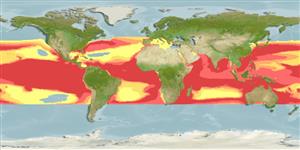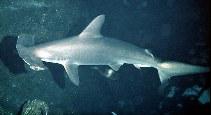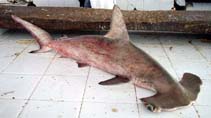個人による観察記録の追加 Fish Watcher
| Native range | All suitable habitat | Point map | Year 2050 |

|
| This map was computer-generated and has not yet been reviewed. |
| Sphyrna lewini AquaMaps Data sources: GBIF OBIS |
Venezuela country information
Common names:
Cornúa
Occurrence: native
Salinity: brackish
Abundance: | Ref:
Importance: | Ref:
Aquaculture: | Ref:
Regulations: | Ref:
Uses: no uses
Comments:
National Checklist:
Country Information: https://www.cia.gov/library/publications/resources/the-world-factbook/geos/ve.html
National Fisheries Authority:
Occurrences: Occurrences Point map
Main Ref: Compagno, L.J.V., 1984
National Database:
Occurrence: native
Salinity: brackish
Abundance: | Ref:
Importance: | Ref:
Aquaculture: | Ref:
Regulations: | Ref:
Uses: no uses
Comments:
National Checklist:
Country Information: https://www.cia.gov/library/publications/resources/the-world-factbook/geos/ve.html
National Fisheries Authority:
Occurrences: Occurrences Point map
Main Ref: Compagno, L.J.V., 1984
National Database:
Common names from other countries
分類 / Names 共通名の | 類義語 | Catalog of Fishes(部類, 種) | ITIS | CoL | WoRMS | Cloffa
板鰓亜鋼(サメとエイ類) (sharks and rays) > Carcharhiniformes (Ground sharks) > Sphyrnidae (Hammerhead, bonnethead, or scoophead sharks)
Etymology: Sphyrna: Probable misspelling of sphyra (Gr.), hammer, referring to their hammer-shaped heads (See ETYFish); lewini: Patronym not identified, perhaps in honor of John Lewin (1770-1819), who illustrated early volumes of Australian natural history (this shark was described from Australia) and may be the “Mr. Lewin” who illustrated the plates in Griffith and Smith’s book (See ETYFish).
Eponymy: John William Lewin (1770–1819) was an English naturalist and engraver. [...] (Ref. 128868), visit book page.
Etymology: Sphyrna: Probable misspelling of sphyra (Gr.), hammer, referring to their hammer-shaped heads (See ETYFish); lewini: Patronym not identified, perhaps in honor of John Lewin (1770-1819), who illustrated early volumes of Australian natural history (this shark was described from Australia) and may be the “Mr. Lewin” who illustrated the plates in Griffith and Smith’s book (See ETYFish).
Eponymy: John William Lewin (1770–1819) was an English naturalist and engraver. [...] (Ref. 128868), visit book page.
Environment: milieu / climate zone / depth range / distribution range 生態学
海; 汽水性の; 海洋回遊性 (Ref. 51243); 深さの範囲 0 - 1043 m (Ref. 89972), usually 0 - 25 m (Ref. 26999). Tropical; 46°N - 39°S, 180°W - 180°E
分布 国々 | 国連食糧農業機関の区域 | エコシステム | 事件 | Point map | 導入 | Faunafri
Circumglobal in coastal warm temperate and tropical seas (Ref. 13562). Western Atlantic: New Jersey, USA to Uruguay (Ref. 58839), including the Gulf of Mexico and Caribbean. Eastern Atlantic: western Mediterranean (Ref. 6678) to Namibia (Ref. 6812). Indo-Pacific: Persian Gulf (Ref. 68964), Red Sea, East Africa and throughout the Indian Ocean; Japan to New Caledonia, Hawaii and Tahiti. Eastern Pacific: southern California, USA to Ecuador, probably Peru.
Length at first maturity / サイズ / 重さ / 年齢
Maturity: Lm 210.5, range 140 - 273 cm
Max length : 430 cm TL オス/雌雄の選別がない; (Ref. 26938); common length : 360 cm TL オス/雌雄の選別がない; (Ref. 13562); 最大公表体重: 152.4 kg (Ref. 40637); 最大記録サイズ: 35 年 (Ref. 31395)
Max length : 430 cm TL オス/雌雄の選別がない; (Ref. 26938); common length : 360 cm TL オス/雌雄の選別がない; (Ref. 13562); 最大公表体重: 152.4 kg (Ref. 40637); 最大記録サイズ: 35 年 (Ref. 31395)
簡単な記述 検索表 | 形態学 | 形態計測学
背面の脊椎 (合計) : 0; 肛門の骨: 0. This hammerhead shark is distinguished by having the following characters: large, moderately slender body; broad, narrow bladed head, arched anterior margin with prominent median indentation and lateral indentation; nostrils with strong prenarial grooves; hind margins of eyes slightly posterior to or nearly opposite front of mouth; teeth triangular, deeply notched posteriorly, with smooth or finely serrated edges; first dorsal fin moderately high, second dorsal and pectoral fins low; upper precaudal pit transverse crescentric. Colour of body light grey or greyish brown above, shading to white below, pectoral fin tips dusky and a dark blotch on lower caudal fin lobe (Ref. 13562, 114967).
A coastal-pelagic, semi-oceanic shark occurring over continental and insular shelves and adjacent deep water, often approaching close inshore and entering enclosed bays and estuaries (Ref. 244, 11230, 58302). Found in inshore and offshore waters to about 275 m depth (Ref. 26938, 11230, 58302); has been filmed at a baited camera in 512 m depth (Lis Maclaren, pers. comm. 2005). Huge schools of small migrating individuals move pole ward in the summer in certain areas (Ref. 244). Permanent resident populations also exist (Ref. 244). Juveniles occur in coastal areas (Ref. 58784). Adults solitary, in pairs, or schools; young in large schools (Ref. 13562). Feed mainly on teleost fishes and cephalopods (Ref. 6871), also lobsters, shrimps, crabs (Ref. 30573), including other sharks and rays (Ref. 37816). Viviparous (Ref. 50449). Mature females produce 15-31, of 43-55 cm young in a litter (Ref. 26938, 1602). Considered potentially dangerous to people but often not aggressive when approached by divers (Ref. 13562). Readily available to inshore artisanal and small commercial fisheries as well as to offshore operations (Ref. 13562). Sold fresh, dried-salted, smoked and frozen; also sought for its fins and hides (Ref. 9987). Oil used for vitamins and carcasses for fishmeal (Ref. 13562). Maximum depth from Ref. 125614.
Life cycle and mating behavior 成熟 | 繁殖 | 放精 | 卵 | 生産力 | 幼生
Viviparous, placental (Ref. 50449), with 13-23 in a litter (Ref. 6871); 12-41 pups after a gestation period of 9-10 months (Ref.58048). Size at birth 45-50 cm TL (Ref. 13562); 39-57 cm TL (Ref.58048).
主な参考文献
Upload your references | 参考文献 | コーディネーター : Compagno, Leonard J.V. | 協力者
Compagno, L.J.V., 1984. FAO Species Catalogue. Vol. 4. Sharks of the world. An annotated and illustrated catalogue of shark species known to date. Part 2 - Carcharhiniformes. FAO Fish. Synop. 125(4/2):251-655. Rome: FAO. (Ref. 244)
IUCNのレッドリストの状況は (Ref. 130435: Version 2024-2)
絶滅寸前の危機的状況 (CR) (A2bd); Date assessed: 08 November 2018
Human uses
水産業: 商業; ゲームフィッシュ: はい
FAO(水産業: 代謝, 種の外形; publication : search) | FIRMS (Stock assessments) | FishSource | 私達の周りの海
より多くの情報
Population dynamics
成長のパラメーター
Max. ages / sizes
Length-weight rel.
Length-length rel.
体長組成
Mass conversion
補充
豊度
成長のパラメーター
Max. ages / sizes
Length-weight rel.
Length-length rel.
体長組成
Mass conversion
補充
豊度
Physiology
Body composition
Nutrients
酸素消費
水泳形態
泳ぐ速さ
Visual pigments
Fish sound
Diseases & Parasites
Toxicity (LC50s)
Body composition
Nutrients
酸素消費
水泳形態
泳ぐ速さ
Visual pigments
Fish sound
Diseases & Parasites
Toxicity (LC50s)
用具
Bio-Quiz | E-book | 野外観察図鑑 | 検索表 | Length-frequency wizard | 生活史の基盤ツール | 目的のマップ | Classification Tree
| Catch-MSY |
特記事項
XMLをダウンロードして下さい
インターネットの情報源
Aquatic Commons | BHL | Cloffa | BOLDSystems | Websites from users | Check FishWatcher | CISTI | Catalog of Fishes(部類, 種) | DiscoverLife | DORIS | ECOTOX | Faunafri | Fishtrace | GenBank(ゲノム, ヌクレオチド) | GloBI | GOBASE | GoMexSI (interaction data) | | Google Books | Google Scholar | Google | IGFA World Record | MitoFish | 国のデーターベース | Otolith Atlas of Taiwan Fishes | PubMed | Reef Life Survey | Scirus | SeaLifeBase | 生命の木 | Wikipedia(行く, 検索する) | World Records Freshwater Fishing | 動物に関する記録
Estimates based on models
Preferred temperature (Ref. 115969): 18.7 - 29, mean 27.2 (based on 2890 cells).
Phylogenetic diversity index (Ref. 82804): PD50 = 0.5029 [Uniqueness, from 0.5 = low to 2.0 = high].
Bayesian length-weight: a=0.00355 (0.00278 - 0.00454), b=3.10 (3.03 - 3.17), in cm Total Length, based on LWR estimates for this species (Ref. 93245).
栄養段階 (Ref. 69278): 4.1 ±0.5 se; based on diet studies.
回復力 (Ref. 120179): 低い, 4.5年~14年の倍増期間の最小個体群 (rm=0.028; K=0.05-0.24; tm=3-15; tmax=41.6; Fec=13-23).
Prior r = 0.06, 95% CL = 0.04 - 0.09, Based on 2 data-limited stock assessments.
Fishing Vulnerability (Ref. 59153): Very high vulnerability (78 of 100).
Climate Vulnerability (Ref. 125649): High vulnerability (62 of 100).





